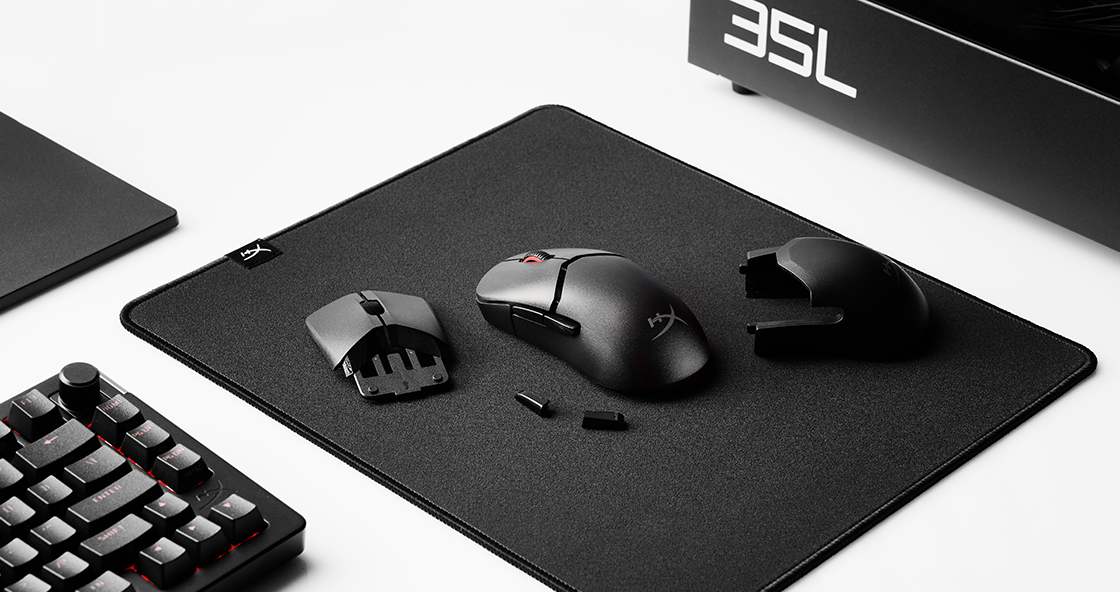Summary
- The new HyperX Pulsefire Saga modular gaming mice allow for customization by swapping parts.
- These mice will also support community-created 3D-printed parts for additional customization.
- Customizable mice could shape the future of gaming, allowing gamers to build mice tailored to their needs.
HP unveiled a bunch of cool tech goodies at CES this year, but the new HyperX Pulsefire Saga gaming mice caught my attention. These mice’s standout feature is that they’re modular, meaning you can customize them to create custom shapes.
What Are the New HyperX Modular Mice?
The HyperX Pulsefire Saga and Saga Pro are new modular gaming mice announced at CES 2025 and are coming out in March 2025. The non-Pro will be wired and have a polling rate of up to 8,000Hz, whereas the Pro will be wireless and support up to 4,000Hz.
The Saga will be priced at $79.99, and the Pro will cost $119.99. While the price gap is significant, those of us who have used a wireless gaming mouse know how much better they are. There are some other minor differences, such as the non-Pro featuring extra RGB and being 3g lighter, but let’s set that aside for now.
What makes these two gaming mice special is their modularity, meaning you can swap out parts to customize the shape. The core of the mouse holds the sensor, switches, battery, and other essential parts, and you can swap out the parts you touch the most.
The box includes two button covers, two mouse shells, and two side button pairs, so you can fine-tune the mouse to your preferences. Since the pieces attach magnetically, they snap and stay in place and are easy to configure on the fly. In addition to the swappable parts, HyperX will sell glass mouse skates, and I hope that they’ll further expand the lineup with even more options, such as custom scroll wheels.
This isn’t the first time we’ve seen modular mice. The Mad Catz R.A.T. has been doing something similar for years. In fact, it’s not even the first time we’ve seen 3D-printed mouse parts—I recently covered the Orbital PATHFINDER, which features numerous 3D-printed panels that allow for vastly different mouse designs.
What matters with the HyperX Saga lineup is that this is a modular mouse created by a mainstream brand, which could mark a new dawn for modular mice. Until now, modular mice have largely been made by niche brands for a small audience.
Moreover, the price point of modular mice has been out of reach for most. For example, the Collector’s Edition (which includes a set of panels) of the Orbital PATHFINDER is $189.00 and requires a pre-order. The HyperX Saga mice are part of the hugely popular HyperX Pulsefire lineup, and their pricing aligns with other high-end gaming mice.
3D Printing Mouse Parts Makes So Much Sense
Perhaps the best part about these mice is that HyperX will release 3D print files for free, allowing for community-created designs. You can experiment with wildly different shapes, filament colors, and materials to create a completely unique mouse that’s also more comfortable to use.
Mice aren’t a one-size-fits-all solution, as many of us have different-sized hands and mouse grip styles. For instance, I have large hands and use a hybrid grip, so I prefer large mice like the Logitech G502. However, large mice often come with extra bulk and tend to weigh in excess of 100g, which isn’t ideal for competitive FPS games. In my opinion, heavy mice make it harder to aim precisely.
If I got the HyperX Saga and 3D printed a lightweight shell—ideally one with thumb and pinky rests—it’d immediately solve my discomfort. And if I found that the pinky rest dragged across the mousepad, I wouldn’t be stuck with the mouse. Instead, I could easily find a different design or, if I were skilled enough, create my own.
You don’t even need a 3D printer to do this. I don’t have one, but there’s an affordable local 3D printing service I sometimes use for my projects. You’d only need to print out a few pieces to figure out your mouse preferences.
Then, whenever you want to make further adjustments to your “Excalibur,” you already have a point of reference and know exactly what to look for. Maybe the side buttons need to be a little taller, or perhaps the mouse buttons could use a more pronounced contour for your fingers. The possibilities are endless with 3D-printed mouse parts.
Customizable Mice Are the Future
Like custom mechanical keyboards, we’re all the better for custom mice. We all have our own unique preferences, so having more options only makes sense. It sparks a conversation around computer mice and other peripherals that didn’t exist before.
That said, these new mice from HyperX aren’t perfect. My main complaint is the non-removable optical mouse switches. I wish they used hot-swappable sockets instead, at least for the left and right buttons.
It’s possible that somebody else will come up with a solution, though. I use a hot-swappable PCB for my G502, which I got on AliExpress for around $10. It even included a pair of TTC Gold 80M switches. It’s possible that we’ll see something similar for the HyperX Saga mice.
It’s great to see a big brand like HyperX create a product for mouse enthusiasts. I believe this could be the breakthrough that modular mice need and deserve. Even if you’re happy with your current mouse, there’s no reason not to experiment with custom shapes to create one that fits your hand like a glove.



